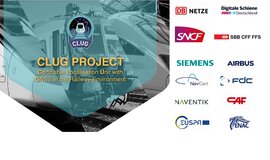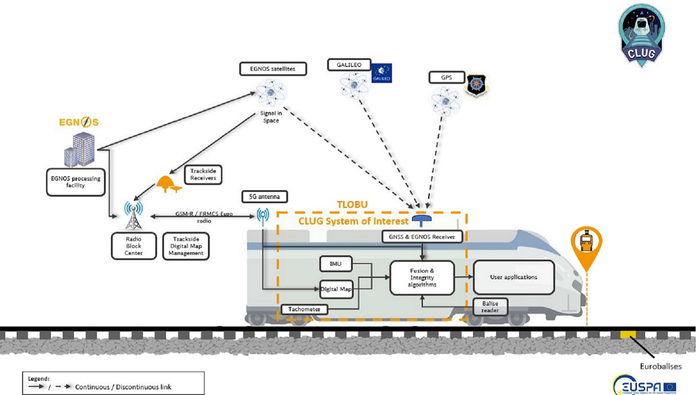
CLUG - A new approach to train localisation using European GNSS
Rail plays a central role in providing environment-friendly transport and helping Germany and Europe meet its sustainability challenges. It remains the best solution for promoting safe, clean and green mobility.
To unlock the full potential of the railways, both for passenger and freight traffic, digitalisation is currently the main enabler. In this context highly accurate and real-time localisation of trains has increasingly become an important topic for the European railway sector.
The railway system has a structural need to know the position of every train in real-time. The EU Parliament in its recently adopted report on railway safety and signalling from July 2021 calls for a joint effort towards the introduction of GNSS for train localisation in the ERTMS deployment [1].
Precise and reliable localisation is a prerequisite for the future railways system, enabling key features such as AI based Intelligent Traffic Management Systems, Automated Train Operation (ATO) and ETCS Level 3 Moving Block, which enables trains to run at optimized and flexible, i. e. “moving” headways. Thus, supporting Europe’s Green Deal targets of reducing CO2 emissions by enhancing railway capacities with lowest investments possible.
Currently, the position of the train for signalling purposes is based on trackside train detection equipment such as track circuits or axle counters, which are mounted devices at specific intervals along the railway track. In addition to the trackside train detection, the train communicates its relative position on the track using a reference point (i. e. position of the Eurobalises) and distance travelled using odometry sensors (i. e. mechanical or doppler radar, wheel rotation sensors, etc).
Onboard train localisation in ERTMS is a major challenge and many organisations including the European Railway Agency (ERA) believe that using GNSS (Global Navigation Satellite System) is a game-changer for the European railway network (see ERA report in 2015 [2]). Applying GNSS technology to the existing ERTMS/ETCS core will help to improve the quality of the localisation information and mitigate the weakness identified due to accuracy of the current odometry system. Due to the reducing of trackside devices this leads also to a system wide gain in reliability of train services and a potential reduction of operational costs.
In short, Europe is pushing for the use of GNSS in the rail sector. The use of GNSS in ERTMS for signalling applications requires detailed evaluation of the safety and performance that can be provided by a GNSS-based on-board localisation system. Supported by EUSPA and funded as an European HORIZON-2020 project, the CLUG project was launched to support and promote the introduction of GNSS in the railway domain.
Certifiable Localisation Unit with GNSS (CLUG)
The CLUG project, started in 2019, brings together a complete consortium of different partners comprising of railway companies (SNCF, DB Netz and SBB), railway signalling industries (CAF and Siemens), navigation specialists (Airbus Defence and Space, Naventik, FDC), research institute (ENAC) and certification expert (Navcert). Within the sector initiative “Digitale Schiene Deutschland” (DSD) DB Netz AG is working together with these selected partners from industry, business and research in this joint project.
The CLUG project was started to explore and assess the use of GNSS for signalling and to enable further applications, such as ATO or an Intelligent Traffic Management Systems. The main objectives of the project are
- Establish the needs, objectives, and top-level functional and performance requirements of the train localisation unit using a “top-down” approach by the railway companies i. e. end users
- Architecture definition and algorithm prototype development for a novel GNSS-based multi-sensor fusion approach to localisation in the railway domain
- Development of process and tools for certification of the localisation unit
- Demonstration of the feasibility of the multi-sensor fusion approach using real-world data collected using train runs in Germany, France and Switzerland.
The CLUG Approach
The proof of concept of the Train Localisation Onboard Unit (TLOBU) in CLUG utilises sensor data from train-based sensors such as GNSS, Inertial Measurement Unit (IMU), speed sensors. Additionally, a digital map providing the track topology including the track centerline with absolute references is used. The CLUG system relies on information from only a minimal number of trackside infrastructure elements i. e. Eurobalises. In addition to GNSS (i. e. GPS or Galileo), European Geostationary Navigation Overlay Service (EGNOS) is used as an satellite-based augmentation service (SBAS) in the navigation core for improving both the safety and performance of the localisation unit.
The sensor data together with the digital map are used by the fusion and integrity algorithm of the CLUG localisation system to determine the position of the train with meter-level accuracy at the required safety levels needed for the different applications.
Location sensing: an important topic at Digitale Schiene Deutschland
On-board train localisation is an important topic for Digitale Schiene Deutschland. Simultaneously we are working in another project, called Sensors4Rail [3], which explores the topic of train-centric localisation with a different approach and focus. In the project Sensors4Rail, the localisation architecture consists of GNSS, motion and acceleration sensors, perception sensors such as cameras, Lidar, Radar and High-Definition digital maps. The difference of this setup is, that it does not rely on trackside infrastructure elements such as Eurobalises, but requires additional perception sensors and the HD map.
Digitale Schiene Deutschland will continue to test different approaches for train localisation and carry out pilot projects in this important area of digitalisation together with leading partners from industry and rail operators. On the one hand, this will allow the emerging solutions and products to be co-designed. On the other hand, it can be ensured that the best technology setup for high-precision train localisation finds its way into the rail system.
Presentation of results
The CLUG project, funded by the European Commission under Horizon Europe 2020 was completed by end of May 2022.
The final event took place on 19th May in Paris. Since we aimed to share our results with a broader public, we organized a CLUG online webinar as well on 9th June 2022.
Here you can download the Agenda and the recording of the CLUG Webinar.
References:
[1] European Parliament: Railway safety and signalling: Assessing the state of play of the ERTMS deploymen
[2] ERTMS Longer Term Perspective: Game Changer Satellite Positioning
[3] Sensors4Rail
